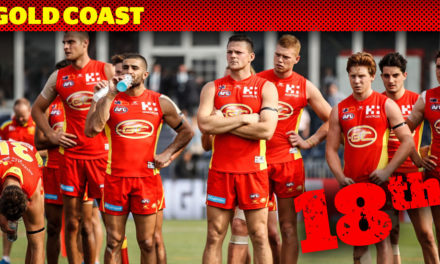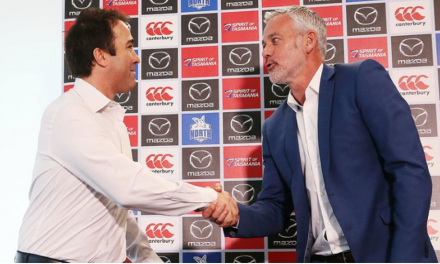Rock, paper, scissors replaced the traditional pre-game coin toss for last Friday night’s AFLX. Photo: GETTY IMAGES
It’s been a strange week or so for AFL football, one of completely contrasting narratives about the health of the game and the priorities of those running it.
The league’s much-documented AFLX experiment has been run, the success or otherwise of last Friday night’s tournament seemingly entirely dependent upon which vested interest group was consulted.
On Sunday, the AFL released its latest figures regarding participation at all levels, the encouraging headline the surge in female involvement in the game.
And in the lead-up to both came more sad news and discussion about the struggles of heritage areas like Tasmania, another historic club from the north west of the state, Smithton, having announced, like too many others, that it would be going into recess.
Is Australian football booming or not? You could argue several different cases.
There seems no shortage of cash to splash around at the elite level, the promotion and staging of AFLX and payments to the players who took part hardly a pittance.
Whether the bastardised version of the traditional game replete with its “super-hero” type themes and impromptu pre-game players’ fashion shows actually draws new generations of fans and players is highly debatable.
But perhaps the AFL isn’t as worried about that anymore given the sorts of numbers which were released on Sunday.
A total of 1,649,178 people worldwide played Australian football last year, a growth of 6.5 per cent. Most significantly, there was a 14 per cent spike in female participation, the 530,166 registered female players accounting for 32 per cent of all participants.
None of which is much comfort, of course, for those connected with the established grassroots clubs falling over left, right and centre. Logically, the boom in women’s football has to result in more investment in facilities at local levels, resources which by extension will also help the men’s game.
That, however, will take some time at least. And that’s something most of those clubs on their knees don’t have.
Which part of the equation should the game be focussing upon? Applying band-aids where required right now, or investing in that growth for future generations? There’s compelling arguments for both, but the staging of an extravagance like AFLX doesn’t sit comfortably with either of them.
The rationale for AFLX has never been convincingly argued by the league, though there was no shortage on Friday night of willing spruikers, most of whom seemed to occupy some spot in the game’s food chain, telling the dissenters to “lighten up” and that it was “just some fun”.
The defendants of the AFLX concept have concentrated on two themes, one making the game more accessible for international markets in terms of facilities required, and second, appealing to kids.
But the league’s commitment to making the game bigger overseas has never been consistent, waxing and waning over a 30-year period. And if three decades of attempting to “sell” the genuine article has been haphazard enough to have left Australian football still a novelty rather than a real sporting alternative, why would another bastardised version of the game suddenly take off?
Notable here if that was indeed a serious argument is that Friday night’s exhibition was still played on an oval despite its rectangular nature, the unused portions of Marvel Stadium used for a catalogue of children’s activities, all of which seemed to be capturing attention as much as the games themselves.
And what of the kids? No one has yet satisfactorily explained what was the point of creating four cheesily-named new outfits for this year’s version of AFLX.
If this was about converting young children to football fans, surely a safer strategy would have been to, like last year, stick with existing teams, ones which will be around beyond a one-off exhibition so that if the kids do stick there’s at least somewhere to direct their allegiances?
And if the genuine product is so good, why not sell that to the kids, the best players playing for real teams and clubs in games which actually mean something and at least have the sort of physical contact and pressure which is a hallmark, not the glorified circle work that most of Friday night’s mini-games proved to be.
More incongruous still, though, was the release of those participation figures barely 24 hours after the AFLX circus.
The league now has tangible proof that it’s on a winner with the women’s game, which can only continue to grow and standards improve with the devoting of more time, energy and resources.
We’re halfway through an AFLW season which has already demonstrated higher quality and plenty of interest. Yet a good week was taken up hyping a totally speculative event like AFLX which never attracted more than lukewarm interest, and for questionable returns.
That was oxygen deprived the AFLW, which at times even this season the league has appeared pretty half-hearted about promoting.
Is it so confident women’s football will continue to thrive it believes it can now, having established an elite level competition, take its hands off the wheel and let the concept steer itself?
That would be both short-sighted and dangerous hubris. A bit like taking for granted the health of the game in long-established football heartlands. Yes, like Tasmania, a state in which football continues to slowly wither on the vine while the game’s leaders are playing with newer, shinier toys.
*This article first appeared at SPORTING NEWS











